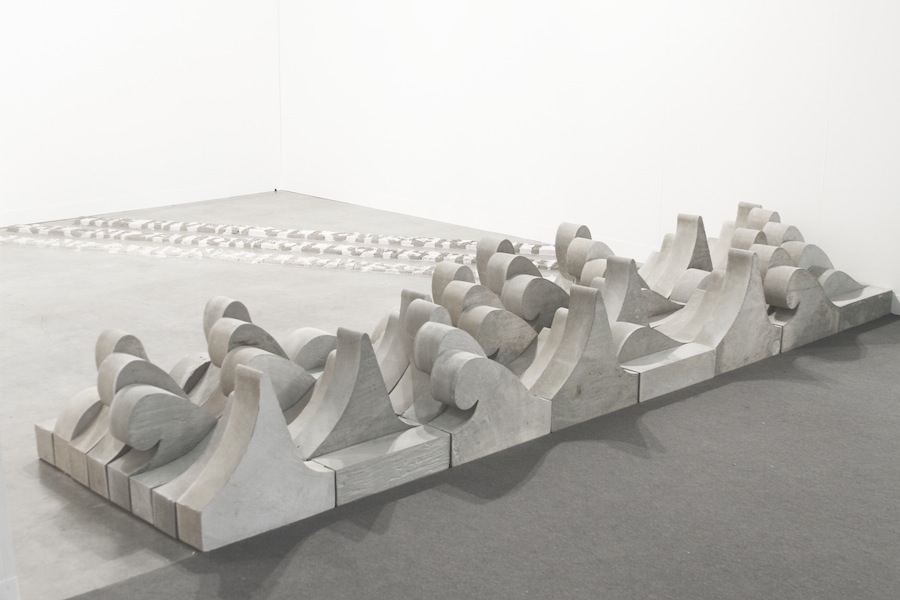Roca Grafito (Graphite Rock)
2012 - Sculpture (Sculpture)
Mateo Lopez
With Roca Carbon ( Charcoal Rock , 2012) and Roca Grafito ( Graphite Rock , 2012), López plays with our relationship to inert and unremarkable objects such as rocks. Traces of art history reverberate through the sculptures; their mediums reflect traditional materials for drawing and sketching, and the simplicity of their forms gesture toward minimalism. But López dislocates these common objects from their ordinary utility by replicating their component parts in paper, graphite, and charcoal, thus drawing attention to mechanisms of representation and translation.
Though he often works with paper and traditional techniques such as lithography, Mateo López is interested in expanding the scope of drawing and frequently operates outside of traditional studio situations to conjure personal experiences. His early studies in architecture equipped him to consider his medium in terms of time and space, and in three rather than two dimensions. The portability of López’s methods, along with his personal approach to collecting information from his personal journeys, has become a trademark of his installations. Drawings and trompe l’oeil objects, ranging from apples to clothing hangers to doors, extend beyond their sources of inspiration as sensuous entities, creating their own life in a Proustian narrative.
Colors:
Related works featuring themes of: » Andes Region, » Art That Plays With Scale, » Contemporary Conceptualism, » Found Objects, » Colombian

© » KADIST
Nicolás Paris
2012Nicolas Paris studied architecture and worked as an elementary school teacher before he decided to become an artist...

© » KADIST
Bernardo Ortiz
2011Casa de la cabeza (2011) is a drawing of the words of the title, which translate literally into English as “house of the head.” Ortiz uses this humorous phrase to engage the idea of living in your head....

© » KADIST
Nicolás Consuegra
2014Consuegra’s Colombia is a mirror made in the shape of the artist’s home country—a silhouette that has an important resonance for the artist...

© » KADIST
Jianwei Wang
2007In Dilemma: Three Way Fork in the Road , Wang references Peking opera in a re-interpretation of traditional text...

© » KADIST
Alessandro Balteo Yazbeck
2008Part of a larger series of photographic works, Alessandro Balteo Yazbeck’s Corrupted file from page 14 (V1) from the series La Vega, Plan Caracas No...

© » KADIST
Pablo Rasgado
2011Pablo Rasgado’s paintings and installations serve as a visual record of contemporary urban human behavior...

© » KADIST
Zarouhie Abdalian
2010The first iteration of Flutter was specifically conceived for the Pro Arts Gallery space in Oakland in 2010, viewable from the public space of a sidewalk, and the version acquired by the Kadist Collection is an adaptation of it...

© » KADIST
Felipe Arturo
2012Primero estaba el mar ( First Was the Sea , 2012) is a system of equivalences between syllables and silhouettes of waveforms cast in cement...

© » KADIST
Milena Bonilla
2009Milena Bonilla’s discursive practice explores connections among economics, territory, and politics through everyday interventions...

© » KADIST
Rivane Neuenschwander
2007Mapa-Mundi BR (postal) is a set of wooden shelves holding postcards that depict locations in Brazil named for foreign countries and cities...

© » KADIST
Ximena Garrido Lecca
2014Destilaciones ( Distillations , 2014) is an installation composed of a group of ceramic pots, presented on the floor and within a steel structure...

© » KADIST
Oscar Munoz
2009In Ante la imagen (Before the Image, 2009) Muñoz continues to explore the power of a photograph to live up to the memory of a specific person...

© » KADIST
Antonio Caro
2016Juego de Banderas (a play on words that loosely translates to both set of flags and game of flags) is a triptych of modified Colombian flags by Antonio Caro...

© » KADIST
Heman Chong
2009With a habit of reading eight to ten books at the same time, Chong paints his two-foot tall novel covers through referencing an extensive reading list (accessible on Facebook) he has kept since 2006...

© » KADIST
Claudia Joskowicz
2009The primary interest in the trilogy is Joskowicz’s use of cinematic space, with long tracking shots that portray resistance to habitual viewing experiences of film and television...

© » KADIST
Choi Jeong-Hwa
2008The application of bright colors and kitsch materials in Flower Tree manifests a playful comment on the influence of popular culture and urban lifestyle...

© » KADIST
Claudia Joskowicz
2014Los rastreadores is a two-channel video by Claudia Joskowicz narrating the story of a fictitious drug lord, Ernesto Suarez, whose character is based on the well-known Bolivian drug dealer, Roberto Suárez...

© » KADIST
Heman Chong
2012The work Calendars is composed of 1001 images of deserted public areas in Singapore printed on pages of a calendar set from the year of 2020 until 2096...


